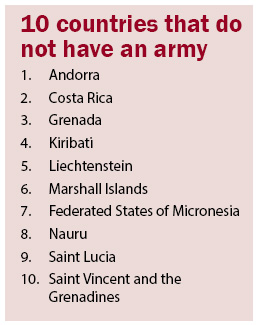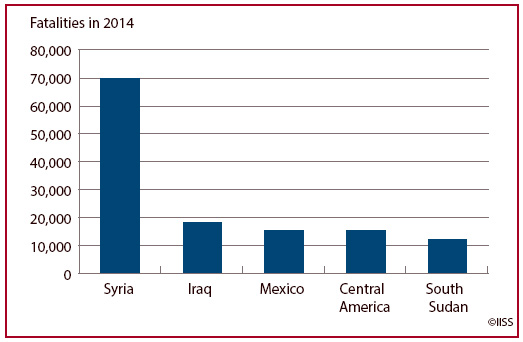PEACE is the greatest illusion today. The whole world is a battlefield. There is no place in the whole physical or virtual world put together that you can call totally peaceful.
As many as 185 out of a total of 196 countries in the world today are currently engaged in some form of armed conflict, civil war, insurgency or other forms of violent unrest. There are only less than a dozen countries in the world today that are not involved in any violence or conflict within or outside their borders.
Just the US alone is involved in 134 wars. These include the recent military actions in Afghanistan, Vietnam, Iraq, Somalia and Yemen besides the global war on terror which has culminated in military actions against the Islamic State, Al-Qaeda and its affiliates and other major counterterrorism operations. On May 1, 2011, US Navy SEALs killed Osama bin Laden in a night raid in Abbottabad, Pakistan. Similar CIA, US Special Forces and counterterrorism operations have been reported in Iraq, Afghanistan, Algeria, Iran, Malaysia, Mali, Nigeria, Pakistan, Philippines, Somalia, Syria and Yemen. A more exhaustive list could involve countries like Indonesia, Thailand, Colombia, Peru, as well as several other countries in Eastern and Central Asia. This is notwithstanding the fact that the US Congress hasn’t officially declared war since 1942.
Some experts believe that America tops the list of countries that have fought the most wars in its 200-year-old history. The British have invaded almost 90 per cent of the countries around the globe. Just 22 out of the 200-odd countries in the world—like Mongolia, Guatemala, Tajikistan, Marshall Islands and Luxembourg—have never been invaded by the British according to a book titled All the Countries We’ve Ever Invaded: And the Few We Never Got Round To.
The only other nation which comes close is France—which also holds the record for facing the brunt of most British invasions.
Prominent among the countries experiencing armed conflicts or war-like situations today include the US, Russia, Afghanistan, Algeria, Africa, Colombia, Congo, Ethiopia, India, Pakistan, Philippines, Somalia, Sudan, South Sudan, Syria, Thailand, Turkey, Uganda, Yemen, Israel, Libya, Malaysia, Mali, Mozambique, Myanmar, Nigeria and Iraq.
In terms of casualties, the largest conflicts are in Afghanistan, Congo, Israel, Iraq, Libya, Nigeria, Pakistan, South Sudan, Syria and Ukraine. The Middle East and North Africa are hotbeds of violence, terrorist activity and revolutionary upsurge. Countries like Syria and Libya are without any doubt the most violent regions in the world. Almost half the population of Syria has been displaced by the civil war.
THESE armed conflicts have forced more than 1 per cent of the global population, or about 73 million people, to leave their homes. According to the Global Peace Index, a report published by the Institute for Economics and Peace, the actual number of refugees and internally displaced persons today is more than even World War II. One in every 130 people on Earth is currently a refugee or displaced—mostly as a fallout of the conflicts in the Middle East. In Syria, alone, 13 million out of 22 million people are displaced. The cost of waging war, homicide, internal security, violence and crimes has reached $14.3 trillion in the past year. Out of this, the cost of supporting refugees and displaced persons is $128 billion—it has risen 267 per cent since 2008.

The number of people killed in conflict has risen from 49,000 in 2010 to 180,000 in 2014. Out of this, the number of deaths from terrorism is estimated to be around 20,000 a year. With groups like Islamic State and Boko Haram expanding their networks, the number of deaths caused by terrorism more than doubled from 8,450 to almost 18,000 in the last eight years. These numbers are expected to increase, according to an Australian research centre.
The conclusion that emerges is that the world today is becoming a more violent and dangerous place to live in. It sometimes feels like the whole world is at war. Things are getting from bad to worse. Looking at things in perspective, roughly 13.4 per cent of global gross domestic product—equivalent to the combined economies of Brazil, Canada, France, Germany, Spain and the UK—is being spent to finance military operations and armed conflicts, according to a report by the Institute for Economics and Peace (IEP).

This brings us to the larger question: Would all this ultimately lead to WW III. If the current situation is not managed, World War III might just be around the corner or already starting.
As King Abdullah of Jordan said recently at a news conference, “we are facing a Third World War against humanity…. we must act fast to tackle the response to interconnected threats.”
Even Pope Francis was quoted as saying “perhaps one can speak of a third war, one fought piecemeal, with crimes, massacres, destruction”, while visiting a military cemetery in Italy.

The whole concept of World War III cannot be dismissed as a figment of wild imagination. The Syrian conflict itself has the potential to spark a global war given the clash of interests at the international level: With Russia and Iran supporting the Bashar al-Assad regime while the US leading a coalition of over 60 countries supporting the Kurds and Syrian rebels fights against Assad’s forces. On the other side of the spectrum, France and Russia have stepped up their own efforts to forge a coalition against the Islamic State. Making matters worse, Turkey is fighting against the Kurds while the Syrian rebels are supported by Jordan, Turkey and the Gulf states.
The picture that emerges from this is grim. All it would take is a slight spark in Iran, Iraq, or Syria to trigger a fiery conflagration in the entire Middle East. This could lead to World War III.
The term ‘world war’ means a military conflict spanning more than two continents, in which at least 20 major countries participate in an attack against a common enemy, and which has the attention of the man-in-the-street due to the significant loss of life When it happened, World War I (1914–1918) was regarded as the “war to end all wars.” World War II (1939–1945) proved that to be false. Today according to World Bank estimates, some 1.5 billion people, roughly one-fifth of humanity, are affected by some form of violence or insecurity.

The US military is involved in operations across all the five continents. It is the world’s largest landlord, with a significant presence in Bahrain, Djibouti, Turkey, Qatar, Saudi Arabia, Kuwait, Iraq, Afghanistan, Kosovo, and Kyrgyzstan, in addition to bases in Germany, Japan, South Korea, Italy, and the UK. Some of these, like the Al Udeid Air Force Base in Qatar, the forward headquarters of the United States Central Command, can accommodate up to 10,000 troops and 120 aircraft.

US forces are active in 20 countries across the Middle East and present in Afghanistan, Bahrain, Egypt, Iran, Iraq, Jordan, Kazakhstan, Kuwait, Kyrgyzstan, Lebanon, Oman, Pakistan, Qatar, Saudi Arabia, Syria, Tajikistan, Turkmenistan, UAE, Uzbekistan, Yemen and some 54 African nations. Some of them are also supporting US Drug Enforcement Agency operations in Colombia and Mexico.
THE Institute for Economics and Peace is worried that conflicts have grown increasingly lethal over the last five years. While the total number of incidents has stayed relatively steady but their death toll has skyrocketed.
In a speech last year President Putin was quoted as saying that World War 3 is ‘inevitable’. He accused NATO of ‘surrounding’ Russia and even signed a document stating that NATO has committed “violations of international law,” which is a very serious and inflammatory charge. In the speech delivered at the Valdai conference in Sochi, Putin made it clear that “Russia will no longer play games with the United States and engage in back-room negotiations…”
“Russia does not wish for the chaos to spread, does not want war, and has no intention of starting one. However, today Russia sees the outbreak of global war as almost inevitable, is prepared for it, and is continuing to prepare for it. Russia does not want war, nor does she fear it…” he added.
“I want to remind you that Russia is one of the most powerful nuclear nations…. This is a reality, not just words,” Putin warned.




























































